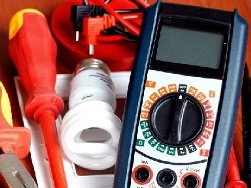Categories: Sharing experience, Electrician Secrets, Electrician at home
Number of views: 93672
Comments on the article: 5
Troubleshooting wiring harnesses
 The article provides practical recommendations for troubleshooting and wiring. The article is recommendatory (like, what, where) and fact-finding.
The article provides practical recommendations for troubleshooting and wiring. The article is recommendatory (like, what, where) and fact-finding.
In this article, we will consider the most common wiring malfunctions in typical apartments.
After a hard working day, when you come home, you find that your apartment does not have light or sockets do not work. Do not panic.
If you live in an apartment where the wiring has not yet changed, then for a start it is worth checking circuit breakers (machines) or fuses in the switchboard.
Most houses have standard electrical wiring. If the house is more than 15-20 years old, the wiring is made of aluminum wire. Over time, aluminum corrodes and breaks down. Typically, this occurs at joints and at bends.
If you open electrical panel, there must be at least three machines. One common, which is up to the meter (meter), and two or three machines go to the consumer. One of the machines is responsible for lighting, the second for the outlet group. If the house is equipped with electric stoves, then another automatic machine is installed for the stove.
To begin work on determining a malfunction in the wiring, you will need the following tools:
1) Voltage indicator - 2 pieces. a) ordinary, on a neon bulb; and b) Chinese, assembled on an LED, a battery and a pair of radio components. Reacts to an electric field.
2) Insulating tape;
3) A portable lamp, obviously working;
4) screwdriver;
5) Knife;
6) Tester (if possible);
7) the hammer;
8) A small chisel.
Check for voltage at the output of the machines; for this, use the voltage indicator. Over time, some machines simply fail. If everything is okay with the machines and there is voltage at the output, there are two outputs - to deal with everything yourself and call electrician.
If you are friends with electricity, try to figure it out for yourself. Today there are many devices for detecting a break in the wiring. If you have this device, then this will greatly facilitate the troubleshooting and troubleshooting, but we will assume that you do not have this device. First, determine which of the groups does not work. To do this, it will be enough to “click” with automatic machines or screw-unscrew plugs.
Next, we need to check on which section of the circuit there is no electricity. If part of the outlets does not work, take a known working lamp and check for voltage in outlets throughout the apartment.
The wiring of the outlet group can be performed in two ways - by a loop, that is, from the outlet to the outlet, which, let's say, is not entirely correct. And the second method is the radiation one, that is, a separate cable is connected from the dose box to each outlet, this is a more correct and reliable way of wiring.
In the event that no electricity was found in any of the outlets, it is necessary to find the nearest dose distribution box at the entrance to the apartment. To do this, it is enough to tap some object on the wall under the ceiling. As a rule, dose boxes are sealed with wallpaper, or covered with a thin layer of putty.
Once you find the box, open it. You will see a few twists there. Use the indicator to check for voltage. Here the “Chinese" indicator will help you. The fact is that the indicator responds to the presence of an electric field in the conductor, if voltage is present, the indicator as it approaches the wire (twisting) should light up. But when working with the “Chinese”, you need a skill, as he sometimes reacts to everything, and you can make a big mistake.
If everything is OK with the voltage, find the next dose box and carry out the same procedure as in the first dose. If at this dose you do not find tension, then a break is between these doses.
If the house is panel, the installation of wires can be done in 2 ways - in the gates and in special channels. If in the channels, it will be enough just to drag the wire. To do this, in one of the doses we tie a new wire to the old wire and in the next dose we pull it. If the old wire is burned out, then to draw a new wire without steel wire can not do.
If the wires are laid in the gates, a hammer and chisel will help you. You only need to knock very carefully, as several wires can be laid in one strobe, and in search of a burnt wire you can damage the whole ones.
Since several groups enter the apartment, you must turn off a known-good one in the shield. It is probably not worth recalling safety precautions. It will be better if 2 people carry out the work. It will be faster and safer. The whole tool must be working. This is especially true for indicators.
The article is advisory in nature and is written from practical experience. Before you start troubleshooting, really assess your skills and capabilities. It would be much wiser to invite a qualified electrician. He will do it much faster and with less “destruction”. Electricity is life threatening and does not forgive mistakes. Good luck to you.
Sergey Seromashenko
Electrical engineering and electronics for beginners, electrical work,do-it-yourself electrician.
See also at bgv.electricianexp.com
:
